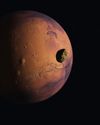試す 金 - 無料
PREPARE FOR PERSEVERANCE THE NEXT MARTIAN ROVER
All About Space
|Issue 105
Launching on 17 July, NASA’s new craft will hunt for signs of past microbial life, cache rock and dig for soil samples – all while preparing for human exploration of the Red Planet

Meet the new Martian rover from NASA, Perseverance. This next-generation explorer was built upon the successes of its predecessors Spirit, Opportunity and the Mars Science Laboratory (MSL), also known as Curiosity. All of these robot explorers have worked towards helping us better understand the planet next door, Mars, and in the wider scope of science understanding the past biology and geology of other worlds. Now the Mars 2020 mission’s Perseverance rover is looking to go even further.
The launch date for this mission is scheduled for 17 July 2020, but the launch window will remain open until 5 August in case of setbacks. It will fly on top of an Atlas V 541 rocket, which also launched Curiosity and InSight, from Cape Canaveral Air Force Station in Florida. However, it won’t be travelling alone. Alongside Perseverance will be a first-of-its-kind demonstration aircraft called the Mars Helicopter – more affectionately nicknamed Ingenuity. After launching the duo will spend over half a year voyaging through space to their destination, where the pair will hopefully land safely in Jezero crater on 18 February 2021. This is located on the western edge of Isidis Planitia, just north of the Martian equator.
After the much-fretted ‘seven minutes of terror’, where mission staff hold their breath for seven minutes as the rover goes through atmospheric entry, descent and landing, the rover will begin its primary mission duration of one Mars year – 687 days in Earth time. During this time Perseverance will inspect the Martian surface for signs of ancient life, characterise its geology and climate, prepare for future human exploration and collect samples of extraterrestrial rock for a future return mission.
このストーリーは、All About Space の Issue 105 版からのものです。
Magzter GOLD を購読すると、厳選された何千ものプレミアム記事や、10,000 以上の雑誌や新聞にアクセスできます。
すでに購読者ですか? サインイン
All About Space からのその他のストーリー

All About Space UK
MYSTERIES OF THE UNI WHERE ARE ALL THE SPIRAL GALAXIES?
There are far fewer spiral galaxies than elliptical ones in the Supergalactic Plane, and scientists are keen to discover why
7 mins
Issue 161

All About Space UK
ZOMBIE STARS
+10 OTHER TERRIFYING SPACE OBJECTS
8 mins
Issue 161

All About Space UK
HOW TO BEAT LIGHT POLLUTION
Thought it was impossible to observe the wonders of the night sky from towns and cities? Think again. Follow our tips and tricks on successfully observing through sky glow
2 mins
Issue 161

All About Space UK
15 STUNNING STAR CLUSTERS
These beautiful stellar groupings are spattered across the cosmos
8 mins
Issue 161

All About Space UK
Eileen Collins "It was a difficult mission...we were the first to see Mir"
Having served as both the first female pilot and first female commander of NASA's Space Shuttle, Collins boosted the involvement of women in space exploration to a whole new level
9 mins
Issue 161

All About Space UK
MARS LEAKS FASTER WHEN IT'S CLOSER TO THE SUN
The Red Planet has lost enough water to space to form a global ocean hundreds of kilometres deep
2 mins
Issue 161

All About Space UK
FUTURE TECH KANKOH-MARU
This ambitious reusable spacecraft will be capable of taking 50 people to and from orbit
2 mins
Issue 161

All About Space UK
THE FINAL FRONTIER
Beyond the reach of the Sun is a fascinating region of the cosmos that were only just beginning to explore
8 mins
Issue 161

All About Space UK
A long-lost moon could explain Mars' weird shape and extreme terrain
A long-lost moon could explain why Mars is so different from the other rocky planets in the Solar System. Today Mars has two tiny moons.
2 mins
Issue 161

All About Space UK
A sprinkling of cosmic dust may have helped kick-start life on Earth
Cosmic dust may have helped kick-start life on Earth. New findings challenge a widely held assumption that this wasn't a plausible explanation.
3 mins
Issue 161
Translate
Change font size
